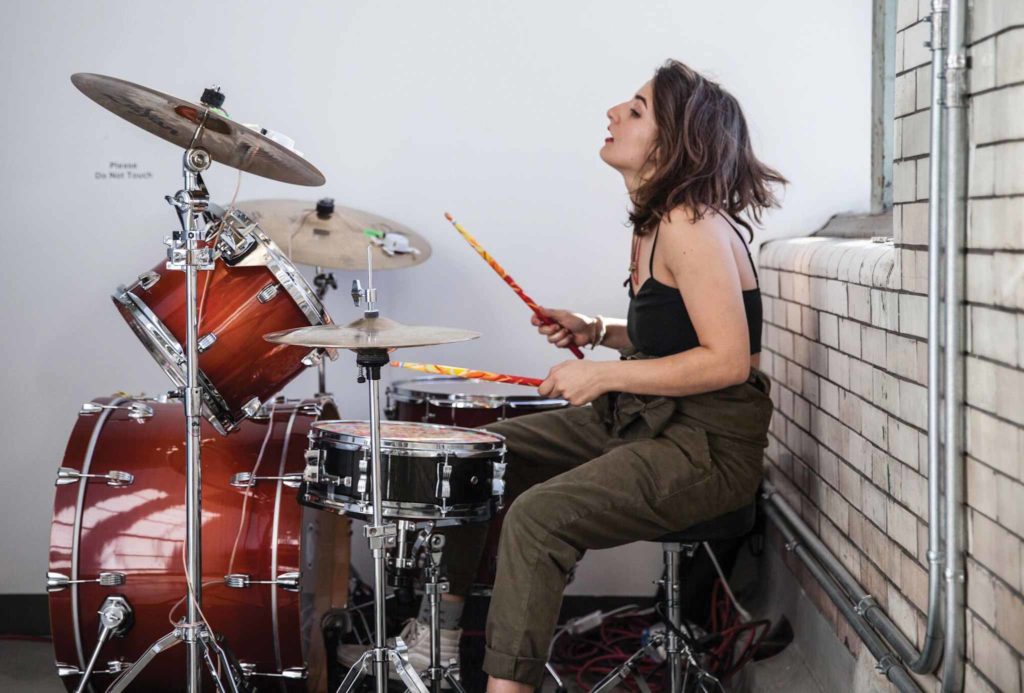By: Pippa Kelmenson
When I was in college, someone surprisingly asked me if my attention and hearing impairments had ever benefitted me in any way. Insulted, I angrily replied, “Obviously not—they’re called deficits for a reason.” Although I refused to see it at the time, I later realized that my interests in electronic compositions and rhythmic patterns relied on the transformation of phrases I heard as a result of my own wavering concentration. Rather than tune out the challenges of being a drummer and an electronic musician with attention deficit disorder and a hearing impairment, I decided to confront them head on and focus on how I could use my adversity for the benefit of my work. It is this dichotomy between hearing as passive reception and listening as active concentration that informs my music.
My sound art and electronic music explore the physical phenomena of sound and human auditory perception. I am mesmerized by psychoacoustics and find myself constantly questioning whether concentration is enough to distinguish the origin of each sonic element. To emphasize the necessity of focus drumming requires, my work strives to accentuate not only the ear as a musical instrument, but also the innate correlation between the machinery of the human body and rhythm.
I am beyond fascinated with the body. When I read Maryanne Amacher’s Psychoacoustic Phenomena in Musical Composition, I felt like a nerdy version of Lindsay Lohan’s character in Freaky Friday when she realizes her similarity to her on-screen mom Jamie Lee Curtis after they switch bodies.
“It is this dichotomy between hearing as passive reception and listening as active concentration that informs my music.”
Amacher writes, “That my ‘ears were emitting sounds’ as well as receiving them . . . was incredible to me, a totally unique amazing experience at the time!” This transformed my idea of the ear as a submissive receiver into a vital, active instrument. It responds to sound information as well as actively amplifying its own. I often use the acoustic impression of low frequency binaural beats and high-pitched, dynamic tones from the ear canal to evoke a particularization of rhythm. The sonic intervals of sweeping, intricately overlapping sound patterns are heard and felt in a rhythmic resonance throughout the body. Not only does this bring attention to the sounds and their polyrhythms, but it also evokes an internal bodily response that the listener is forced to confront.
In the past, I have created analog electronics that transmit the waves of the brain and heart into rhythm. I used these when performing live. For the first part of my senior thesis in the electronic music department at Bard College, I built a larger-than-life ear canal that emits ear-related tones in a sound installation. I recently executed the second part of my senior thesis as a performance including all original compositions that further investigate the internal perception of sound, by surveying auditory and rhythmic illusions.
“This transformed my idea of the ear as a submissive receiver into a vital, active instrument. It responds to sound information as well as actively amplifying its own.”
By utilizing sound as both a form of art and as a medium, these immersive installations and performances benefit from sonic distraction to investigate the body as an instrument and listening device.
One thing each of my works includes is the trope of attention and hearing, both lost and retrieved, as if the listener must reassemble a strayed train of thought.
This article was featured in the Nepotism issue of Tom Tom. Purchase it online.


